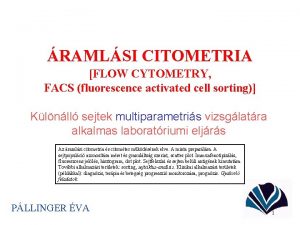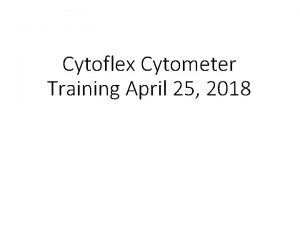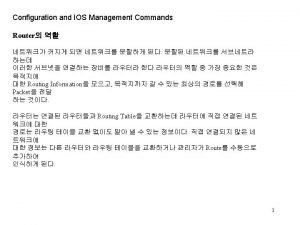Digital cytometer setup and QC Holden T Maecker


























- Slides: 26

Digital cytometer setup and QC Holden T. Maecker

Outline • What do we care about in terms of cytometer performance? • What factors influence performance? • What can we measure and track over time? • What software adjustments are available? • What QC parameters to look at: • Initially on instrument setup • Periodically (daily) • With each experiment

What’s important to cytometer performance? • Resolution Sensitivity: • Q = optical detection efficiency • B = background • Linearity: • Relative ability to detect fluorescence differences across the detection scale • Stability over time

Factors influencing sensitivity, linearity, and stability • Fluidics: • System pressure and stability • Optics: • Laser type and performance • Optical path, filters • Electronics: • PMT type and performance • Signal processor performance

What can we measure and track? • A set of beads of multiple intensities: • Resolution of dimmest bead populations and/or dim bead CV (sensitivity) • Brightness ratio of two bead populations across detection scale (linearity) • Voltage required to achieve a certain bead brightness (stability) • Old: 8 -peak Rainbow beads (Spherotech) • Diva 6. 0: CS&T beads (BD)

Standard bead sets 8 -peak Rainbow beads: CS&T beads: Bright 2 µm 3 µm Dim Mid FSC FITC

What adjustments are available? • Laser delay • Window extension • Area scaling factor

What is laser delay? Time from intersection of 1 st to 2 nd laser Time from intersection of 1 st to 3 rd laser • Dependent upon sheath velocity • Can be mitigated by larger window extensions

What is a window extension? Time window over which a pulse signal is measured • Zero is the narrowest window, two is default • Larger window extensions can overcome minor imprecisions in laser delay setting

What is “area scaling factor”? • A factor that is applied to the pulse area measurement to equalize the height and area scales • Should rarely need to be adjusted • Is important to keep bright events on-scale in both area and height

What to measure and when? • Initial instrument characterization • Periodic (daily) performance check • Experiment-specific setup

Initial instrument characterization • Objective 1: characterize instrument sensitivity and linearity • Old method: • • Run 8 -peak rainbow beads Set voltages so brightest bead is ~105 Observe separation in each detector (no std) Manually adjust laser delay & area scaling factor • Diva 6. 0: • Run baseline optimization routine

8 -peak Rainbow beads

CS&T Baseline Optimization Report

Initial instrument characterization • Objective 2: find baseline PMT voltages that maximize resolution sensitivity • Old method: • • Run peak 2 beads at a series of voltages (350 -800 volts) Export CV of tightly-gated singlet beads for each detector Plot CV versus voltage for all detectors Lowest plateau voltage is the minimum baseline voltage for that detector • Run mid-range (peak 3) beads at minimum baseline voltages, record mean in each detector (these are your initial baseline target values) • Diva 6. 0: • Part of baseline optimization routine

Manual determination of baseline PMT voltages

Automated baseline PMT voltage determination in Diva 6. 0 Determining Baseline PMT Voltages Baseline PMTV is set by placing the dim bead MFI to equal 10 X SDEN 460 V SDEN

Periodic (daily) performance check • Manual method: • Open Exp 1 (8 -peak beads) • Run a new tube of 8 -peak beads with same voltage settings • Compare histograms to initial run • Track at least one peak from each detector for MFI and CV over time • Diva 6. 0: • Run system performance check

Performance Tracking • All measured performance parameters are tracked: • Linearity, CVs, Q and B, laser alignment • PMT voltages required to hit target values • Data is analyzed in Levey-Jennings plots PMT Voltage 550 FITC Channel (Blue laser) 525 500 475 450 425 400 10/22/04 11/11/04 12/01/04 12/21/04 01/10/05 01/30/05 02/19/05 03/11/05 Time

Experiment-specific setup for a new panel • Set voltages to achieve baseline target values • Run single-stained Comp. Beads to see if each bead is brightest in it’s primary detector • If not, increase voltage in the primary detector (!) • Run fully-stained cells and: • Decrease voltages for any detectors where events are off-scale • Increase voltages for any detectors where low-end resolution is poor (necessary? ) • Re-run single-stained Comp. Beads and calculate compensation • Record experiment-specific target values. • Run samples.

Comp. Beads as single-color controls Comp. Beads provide a convenient way to create single-color compensation controls: • Using the same Abs as in the experimental samples • Creating a (usually) bright and uniform positive fluorescent peak • Without using additional cells

Experiment-specific setup for existing panel • Set voltages to achieve experiment-specific target channels. • Run single-stained Comp. Beads and calculate compensation. • Run samples.

Why not put unstained cells in the first log decade? • Autofluorescence varies by detector (very low in far-red range of spectrum) • Leads to highly variable setup • No guarantee that performance on stained cells will be optimal

Why use target channels rather than voltages? Once optimum voltages for a particular experiment are determined, the settings can be captured as target channels (median of mid-range beads in each detector). These target channels are more robust to instrument changes than are the voltages themselves.

Summary • We want our instruments to have good sensitivity, linearity, and stability. • Many factors contribute to sensitivity, linearity, and stability, but we can track the net results using a set of standard beads. • Good setup and QC involves initial instrument characterization, daily performance checks, and experiment-specific setup. • The CS&T module in Diva 6. 0 automates much of the QC workflow.

Diva 6. 0: Making instrument setup and QC so easy, a child can do it. * *Not an official BD claim. The child shown here has never run Diva 6. 0, but she’s watched her daddy do it.
 Flow cytometry
Flow cytometry Flow cytometria vizsgálat
Flow cytometria vizsgálat Setup time and hold time in digital electronics
Setup time and hold time in digital electronics Catcher in the rye chapter 13 quotes
Catcher in the rye chapter 13 quotes Randy adderson personality
Randy adderson personality The outsiders character list
The outsiders character list Catcher in the rye sunny
Catcher in the rye sunny Why doesnt holden throw the snowball
Why doesnt holden throw the snowball 193.
193. Chapter 16 catcher in the rye
Chapter 16 catcher in the rye Dhiraj holden
Dhiraj holden Joanna holden
Joanna holden Catcher in the rye timeline
Catcher in the rye timeline Is holden caulfield a protagonist or antagonist
Is holden caulfield a protagonist or antagonist Bjørn holden
Bjørn holden Catcher in the rye poem
Catcher in the rye poem What does holden fantasize about
What does holden fantasize about Catcher in the rye scrapbook
Catcher in the rye scrapbook Holden tornado
Holden tornado Catcher in the rye unreliable narrator
Catcher in the rye unreliable narrator Catcher in the rye timeline review
Catcher in the rye timeline review The catcher in the rye chapter 26
The catcher in the rye chapter 26 Dashing through the snow in a rusty holden ute
Dashing through the snow in a rusty holden ute Georgina holden
Georgina holden Holden sunny
Holden sunny Why are the ducks important to holden
Why are the ducks important to holden Janice miner holden
Janice miner holden

















































